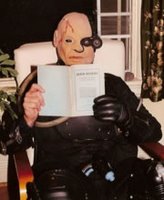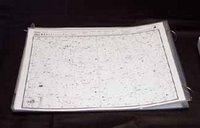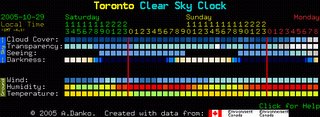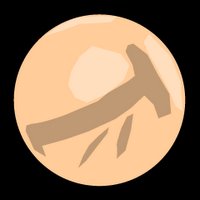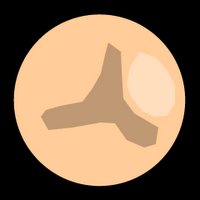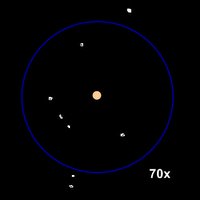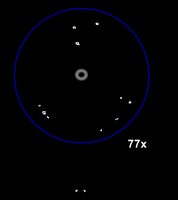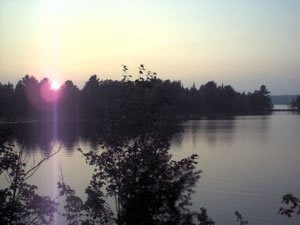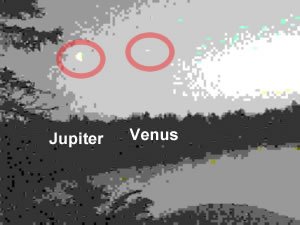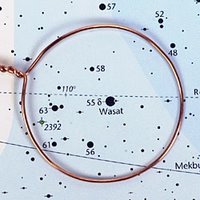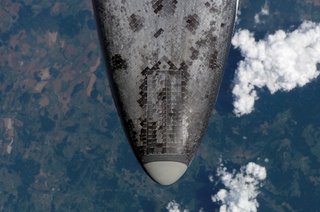While I had packed many of my books and charts and planispheres and all our eyepieces and my red flashlights and my Mini Maglite night vision accessories, it wasn't looking like it was going to be very nice out, based on first impressions at 7:30am. But after I had arrived at Mom's and as I was helping with errands around the yard, it turned into a pleasant, sunny afternoon. There was lots of blue in the sky. So, I thought it might be a good idea to set up the reflector 'scope.
- location: Union, Ontario
- time: 4:30pm - 8:45 EST
- temperature: 6ºC
- humidity: 60%
- seeing: 9 / 10 (very steady; too bad it was so windy)
- transparency: excellent
Clouds, from the lake, from the south, came in later.
For the first time, I carefully checked Ursa Minor to gauge the sky’s transparency. Early on, I could easily Alpha, Beta, and Gamma. Later I could make out the middle handle stars, and the one near Beta (SAO 8024), all about mag 4.4. And after checking the position, I confirmed the 5.0 mag star (SAO 7958) a bit further from Beta.
§
I fired up
RedShift 2.0 on Mom's iMac at around 3:00pm to see what planets would be up. Mercury was trailing the sun! Ooh. It'd be good to see this elusive planet again (although Sky & Telescope said it would be hidden in the glare). Venus would be high up at sunset, at about 20º altitude—an easy target. And Mars would be rising at sunset.
On loading the Fingal Clear Sky Clock, I noticed that it was not dark later in the evening. Right! A gibbous moon would be rising. I had seen waning Luna last night, rising through the trees over the Runnymede subway station.
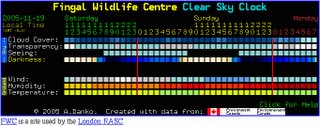
Double-checked the sunset time. It would happen at around 5:00pm. Yikes! That was 2 hours away. If we're gonna do this, we better get a move on.
I set the 'scope up on the back porch. While waiting for it to darken, I noted some of the labelling and printing on the 'scope proper and the base.
- There is a small metal plaque under where the finder scope would be mounted, between the clamps. It simply says: Edscorp, Edmund Scientific Co., Barrington New Jersey.
- On the primary mirror, on its back, embossed in the glass, it says: Pyrex, Made in USA. Elsewhere: 6”D.
- There’s a sticker in the middle of the primary mirror from UPCO OPTICS. There’s some interesting fine print alluding to specifications for building the mirror and what looks like an inspector number.
- On the tripod, Edmund Scientific Co. is embossed in the metal everywhere. The code C2058 shows on the base cap. And on the equatorial mount, B-2088 or B-2089 shows.
The clock drive motor has the following printing:
- CRAMER DIVISION, Old Saybrook, Conn.
- Type 117, P27MABA3, 18A1XA08A-L, date 6 72, RPM 1/15 V115, CY60 W2.7
- CONRAC CORP
It has a 96 tooth ring gear and a single helical worm gear.
I measured the main telescope tube: it’s 47-5/8” long.
The mirror's getting dirty...
I kept watching the sun and trying to spot Mercury. But when the sun set, it was behind the neighbour’s barn (not to mention the hills). If the 4º elevation from
RedShift is correct, then I definitely will not be able to see it. I turned south and kept looking about 20º up and—bam—there she is! How did I miss her earlier? Bright, Venus is almost due south, well up over the trees on the hill. I turned the telescope to her, switched on the Telrad, and called out to Mom.
Venus showed very clearly in the reflector at lowest power (the unmarked eyepiece and my Celestron 26mm seem about the same). The Meade 18mm doubled the effective size. A pretty bright crescent at 5:15pm. Mom asked me if it’s The Moon. She’s surprised by the shape but understands why Venus shows this way. I quickly sketched it.
 scan of my Venus sketch, inverted colour in Fireworks
scan of my Venus sketch, inverted colour in Fireworks
up is down, east is west
The clock drive is not working. I mean, the motor’s running but it’s not engaged, it seems. I thought (after I replaced the bent screws) I had figured out the clutch mechanism. Where’s a User Manual when you need one...
As it darkened and while I waited for Mars to climb, I decided to try for Uranus in Aquarius. Sky & Telescope says it’s magnitude 5.8. So I should be able to see it! I look up the coords in RedShift: 22h35m by -9º43’. I looked up this location in Tirion’s
SkyAtlas. But I got frustrated with the pages blowing around in the wind, losing my dark adapted vision in the bright red light, and struggling with my deteriorating close vision (I need bifocals). I remembered that I can use the telescope’s integrated setting circles. I looked up the middle star in the Water Jar (22h29m by 00º00’). After 3 or 4 attempts, I gave up. At least, I learned a new constellation...
Aquarius has no particularly bright star. I could see Fomalhaut below. I need to look up some constellation patterns to get a better sense of the asterism...
I’m a little surprised that Andromeda is still visible. I could easily see Messier 31 (M31) without aid.
The Milky Way is visible.
At 7:45, I saw a bright meteor, yellow in colour, travelling due west, from the direction of Taurus. It was visible for about 30º before burning out. A Leonid would be from the north, no?
(On checking my meteor shower "calendar" in my palmtop, I learn it was a Taurid, of course! They run from 10 Oct to 5 Dec, peaking on 1 Nov. They are described as having "persistent" trains. I would agree.)
I turned to Mars. Once again, I tried our combined 4 eyepiece set. The Edmund and Celestron 26mm seemed the same. The Meade OR18mm is quite good. I have discovered that the way the Edmund focuses combined with the Meades is odd. At first, I couldn’t focus the 18mm. But I unscrewed from the 4mm and changed the inner tube piece. Then I could focus the eyepiece. Just barely. The 4mm, even with the shorter inner tube, cannot be focussed! This is weird! Or someone was scammed. I forgot to try the doubler.
I cannot make out any Martian details really. Maybe, there’s a dark patch in the middle. I keep thinking there some bright white patches but it's probably my imagination. Mars is smaller in the reflector than my cat 'scope. And the wind continued to shake the OTA or deck or both. I got frustrated again.
And I grew frustrated at getting frustrated! In an effort to make something worthwhile of the evening, I pushed myself to measure the true field of view of all the eyepieces (save the 4mm). While the neighbour’s security light is on, I reviewed my notes.
It took a few tries but I figured out the drift angle and I started timing. I used Zeta Aquarii again, the centre star of the Water Jar, which is right on the celestial equator.
| eyepiece | mm | time enters and leaves | duration |
|---|
| -------------- | -------- | --------------------------------- | -------------- |
|---|
| Edmund | ? | 8:03:55 - 8:08:15 | 4:20 |
| Celestron | 26 | 8:10:35 - 8:14:45 | 4:10 |
| Meade | 18 | 8:16:40 - 8:18:55 | 2:15 |
So, it does indeed look like the Celestron is more powerful. But only slightly. Maybe it is more noticable on the cat 'scope.
As I adjusted the angle and timed with the Edmund eyepiece, I observed a great deal of distortion at the edge of the field. And, oddly, that the eye relief is poor. The Celestron, by comparison, blows it out of the water: clear, crisp, flat imaging to the edges; sharp, well-defined edge; easy eye relief.
At various times, I used Mom’s small binoculars. They’re great for the Pleiades and M31. They are Canon 8x23A specs, with a 6.4º field. Oh, I should make a viewing ring for these binocs too.
When Mom returned home, we checked out Mars together. She noted it was less colourful; when she had left, it was very close to the horizon in the west, ruddy in colour. Now it’s pale, tan. The wind had picked up so it was hard to concentrate. She recognised the Pleiades with her naked eye. I turned the 'scope to them to show her how “busy” the field is, that it’s filled with hundreds of blue-white stars. She enjoyed that. And finally we looked at the Andromeda galaxy which was directly overhead—she had never seen it before.
In summary, the highlights:
- gathered more data about the 'scope
- gauged sky transparency with Ursa Minor
- observed and sketched Venus crescent
- tested clock drive (unsuccessful)
- tried for Uranus (unsuccessful)
- examined Mars with reflector (smaller, too windy to make out detail)
- measured true field of view of 3 eyepieces
- shared 'scope with Mom
Lots of homework to do...
§
Ran into a snag at Mom's! I couldn't update my blog there. Her iMac with OS 9 running the Mozilla 1.2 browser is not compatible. Damn. That's the whole point. That I can update my blog from anywhere... Gonna have to look into this further.







